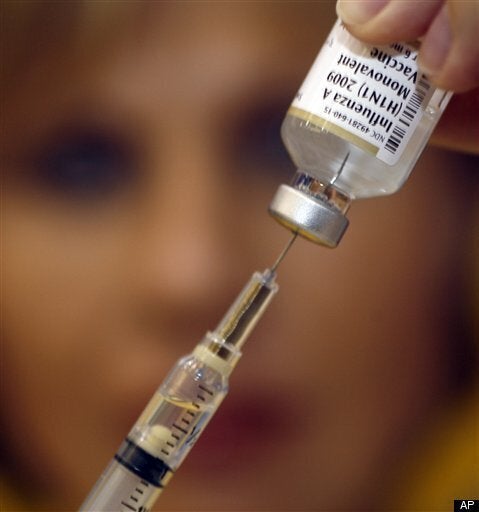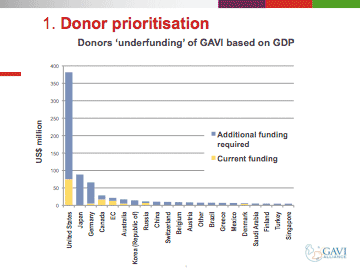
Born out of a commitment at the 2000 World Economic Forum (see video by clicking here), the GAVI Alliance is having its 10th anniversary as a life-saving partnership in Davos, Switzerland this week. There is much to celebrate as the efforts of GAVI and its partners have led to immunizations that will avert an estimated four million deaths from vaccine preventable diseases in the developing world.
To appreciate the accomplishments of the past ten years it helps to recall the "good old days" before GAVI. One thing is for sure: things weren't nearly as good for global vaccines before GAVI as they are now.
In 1996, while working as an epidemiologist at CDC, I assisted the World Health Organization and GAVI's predecessor, the Children's Vaccine Initiative, in developing the first "agenda" to accelerate the introduction of Hib and pneumococcal vaccines. This work was driven by $5 million over five years from USAID. We convened all the key stakeholders to divide the money as effectively as possible. All the suggested solutions were within the envelope of $1 million per year. Not one person at that table ever said, "Hey, let's go to the richest man in the world and have him donate $750 million to buy the vaccine." And no one dreamed that we might in turn raise billions more from that initial funding. Catalyst for ChangeThat is of course exactly what happened when the Bill & Melinda Gates Foundation provided $750 million in funding to GAVI at Davos in 2000. So, the first and most obvious success of GAVI is that it elevated global funding for vaccines and immunization to a new level and taught us to think big.
And big is indeed what came from the first ten years of GAVI. The early days spawned a set of innovative financing mechanisms -- the International Finance Facility for Immunizations and the Advance Market Commitment -- that have helped to grow immunization financing by several fold over this period. These mechanisms are now also being considered as models for other health priorities and even sectors outside of health like climate change and agriculture.
Unrealized PotentialA thoughtful critique of the past ten years should acknowledge, however, that some ambitions have not been met. One example is vaccine pricing. When GAVI started it was expected to drive down the price of a pentavalent combination of DTP-HepB-Hib within a few years. "With $750 million to buy vaccines for the poorest countries of the world, how can we not get lower prices?" went the prevailing wisdom. And yet, nine years later, the price of this vaccine remained virtually unchanged and most importantly, not any lower than the price that middle income countries like Brazil and Mexico pay. Multiple factors have contributed to the lack of price decline but this issue requires a full court press in 2010 if the Alliance wants to fulfill its ultimate promise for developing countries and return its investment to donors.
Opportunity Brings ResponsibilityBecause of its success GAVI is now facing its biggest opportunity -- to roll out new vaccines against diarrhea and pneumonia, the biggest killers of children -- and its biggest challenge, an annual financing gap of ~$500 million per year. So with its 10th anniversary upon us it is time for GAVI partners -- all of them -- to step up and fill this gap.
First, the donors need to increase their funding to match the expanded scope of work that they have given the Alliance. The Bill & Melinda Gates Foundation and the US government should lead this effort. Both were early supporters of GAVI, and both can do more. With the Alliance now working to introduce more new vaccines and save even more lives in the coming decade, larger funding commitments are appropriate and more important than ever.
Consider that the US government's annual commitment to the Global Fund for AIDS, TB and Malaria is going to be $750 million next year, while its commitment to GAVI is only $78 million and you can see that it is not too much to ask the US to increase its commitment to GAVI to provide highly cost-effective vaccines that promise to save millions of lives.

The next contribution needs to come from the private sector. The vaccine manufacturers -- both big pharma and emerging market based -- sit on the GAVI Board so they know the budget constraints and the opportunities. They know that one of GAVI's accomplishments has been moving people from the expectation that vaccines need to be pennies a dose to a realization that they are worth more than that. However, for GAVI, procuring the pentavalent DTP-Hib-HepB vaccine is now a major cost driver. Industry can contribute to filling the financing gap by reducing their prices to save GAVI $50 million or more every year. More importantly, this would send a valuable signal to the most important stakeholder in GAVI -- the developing countries themselves. The companies who have profited the most from GAVI in the past ten years should be the first to act.
Finally, by meeting (or even slightly exceeding) GAVI's expectations for national self-financing of their vaccine programs, developing country governments can make up the remaining funding gap and signal back to the rest of the world that they are prepared to break away from dependency.
The efforts of GAVI and its partners have already prevented millions of child deaths and improved health around the world in ways that were unimaginable when we were dividing up $1 million a year in 1996. The next ten years could lead to even greater health improvements by introducing more vaccines for preventing pneumonia and diarrhea, the leading killers of children worldwide, and strengthening systems to reach the world's most vulnerable populations.
Whether that ambition is realized will largely be determined by the choices made by donors, countries and the vaccine industry at Davos this week, and in the weeks ahead by people like Bill Gates and President Barack Obama.
This decision is too big, with too many lives on the line, to let them make it without hearing from others. So I sent Bill Gates (@BillGates) a tweet. I thanked him for his leadership and vision and asked him to step up again for children by increasing his funding to GAVI over the next ten years. I urge you to do the same, as well as to tweet Senate Foreign Relations Committee Chairman John Kerry (@JohnKerry) and Ranking Member Dick Lugar (@senatorlugar), who will have a major hand in future decisions about global health funding. Or even more simply retweet this post by clicking on the button above. The opportunity to save millions of lives is simply too big. If you care about this issue, please take a second to let them know.
